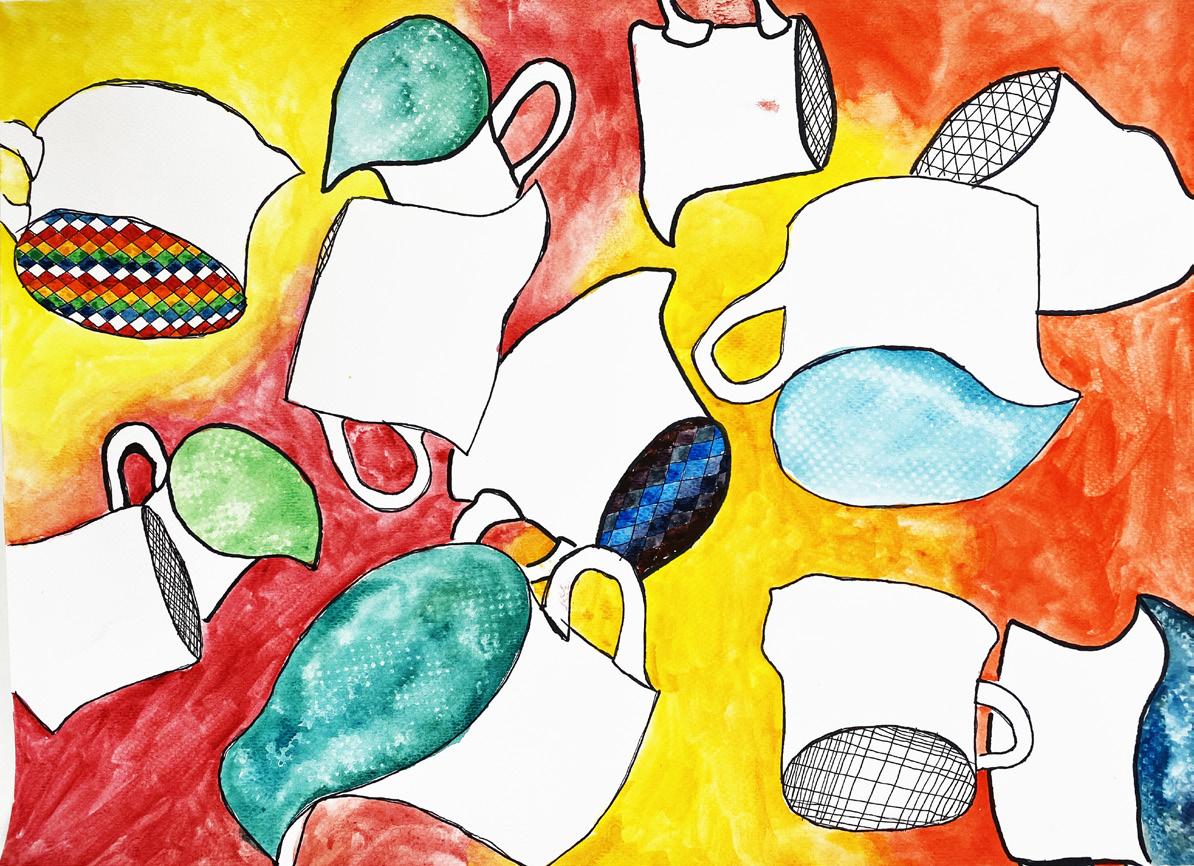
22 minute read
International Schools During COVID-19 Outbreak
Some Suggestions Personal Daily Routines. I recommend each person develops their own special daily routines while in quarantine. Adding structure to your days really helps the time to go by. I have certain morning routines, meal routines, exercise and wellness routines as well as scheduling when my work time is and when is my down time. Be thinking before you come back to China, what you want to do with your time in quarantine and how you can make it a meaningful opportunity for yourself versus just a challenging inconvenience.
Stay in touch. Another strong recommendation is to make a plan for regular communication with friends, family, coworkers and your school throughout your quarantine time. I find I look forward to these calls the most each day! I also strongly encourage schools to systematically set up a support structure to assist returning people with managing their quarantine experience. Care packages matter! I have been fortunate to receive several welltimed care packages and special meals from my staff, board, PTA and friends. Each one is a gift and a bright ray sunshine and joy in the quarantine experience!
Closing Reflections While this experience is not ideal, I believe it is very manageable if people approach it with the right mindset, some preparation and having some support on the ground to assist you. You are likely to feel a whole range of emotions as you process everything through the arrival and quarantine experience. This is normal but is important to know, with confidence, that it is doable! You have a community to support you along the journey. It can be tough at times but stay positive and stay connected to your people! At the end of your stint, you’ll be back in your own bed in your home IN CHINA. After such a long time away, what can be better than that! Good Luck!
CAMPUS DEVELOPMENT International School of Beijing Unveils New Facilities
Early Years Learning Community & Early Years Classroom The Early Years Learning Community supports the school’s Early Years program philosophy of differentiation, play-based, and inquiry-based approaches to learning, by offering flexible learning spaces. the school continues to live its Mission and Vision and provide challeng-

By Nick Yates, International School Beijing Communications
At the start of the 2020-2021 academic year, the thought going through most people’s heads as they walk round the International School of Beijing (ISB) has been “Wow!” The school’s new facilities are, quite simply, excited to open the two brand-new projects – the ES Arts Center and
stunning.
After a highly unusual Summer Break, this is the moment the whole ISB community has been waiting for as students have begun learning in a new Elementary School (ES) Arts Center and Theater, Middle School (MS)/High School (HS) Performing Arts Center, Early Years Learning ning, including extensive community input and consultation, to ensure ing and joyful learning for all. We have finally seen some of the most significant construction projects in ISB’s history come to fruition.
The FMP was divided into new-build and remodel projects. ISB was Community (EYLC), and MS/HS Design Center.
Theater, and the MS/HS Performing Arts Center – in February, just as Covid-19 forced the temporary closure of campus and a period of online learning. They have since been joined by the remaining two remodel projects – the EYLC, and MS/HS Design Center in the fall.
The EYLC is a large, purpose-designed space to better serve ISB’s youngest learners. It features 13 classrooms, lofts, and large common
spaces for Early Years 3, Early Years 4, and Kindergarten students. There’s an early years art classroom, music classroom, and student kitchen. Child-sized facilities and indoor play spaces are connected to outdoor play spaces. The MS/HS Design Center is a centralized facility for showcasing design and engineering programs. Designers can work in a robotics and electronics lab, fabrication lab, finishing lab, three HS art classrooms, and three flexible collaborative spaces. This area of the school provides inspiring spaces to facilitate interdisciplinary and project-based learning. The ES Arts Center and Theater is a flexible, creative performance/ practice space unlike any other on campus, expressly designed to meet the needs of ES performers and audience members. It includes a purpose-built theater, performing arts classrooms, elementary art classrooms, and demonstration areas. ISB values the creative arts alongside academics in whole child development. By increasing co-curricular options, this new space gives a greater range of options for students to meet individual success. Similarly, but for more senior thespians and artists, the MS/HS Performing Arts Center was purpose-built to create a space for the growth of ISB’s dynamic performing arts programs. The center includes specially designed performing arts classrooms and practice rooms (band, orchesMiddle School/High School Design Center The MS/HS Design Center showcases ISB’s design, engineering, and entrepreneurship programs which challenge students to create, prototype, and iterate ideas, through a centralized design facility. Elementary School Arts Center and ES Theater ISB’s ES Arts Center and Theater is a flexible, creative performance/ practice space designed to meet the needs of ES performers and audience members. Includes a purpose-built theater, performing arts classrooms, elementary art classrooms, and demonstration areas.
tra, choir, drama, and dance) with consideration for acoustic, lighting, and flooring requirements.

Gerrick Monroe, ISB’s Chief Financial/Operating Officer, explained the genesis of these new facilities and how they strengthen student learning.
“Regular revisions of ISB’s Facility Master Plan are made to ensure that facility modifications and additions are relevant and vital to the success of our innovative and changing programs and in line with our goals of providing world-class facilities that best meet the educational needs of our dynamic school community,” he said.
“Flexible spaces allow for seamless changes in the daily programs and activities and are also more easily repurposed to meet the changing programmatic needs of a dynamic learning organization over the long

term.” Middle School/High School Performing Arts Center The MS/HS Performing Arts Center was purpose-built to create a space for


the growth of ISB’s dynamic performing arts programs
CAMPUS DEVELOPMENT You Are What You Eat (CDNIS Renovates Cafeteria and Revamps Lunch Menu)

The main cafeteria, located on the 6/F of the Canadian International School of Hong Kong campus, has been a gathering place for students, staff and parents alike for many years. A place where friends meet for lunch or a quick coffee at the Maple Cafe, and also where the community gathers to sample the great offerings of the International Food Fair during the CISPA Family Fun Fair, to make mooncakes ahead of the Mid-Autumn Festival, or to participate in one of the annual ‘PaintYour” events put on by the Habitat for Humanity Club. A few years ago, when the school began crafting its strategic plan it was no surprise that renovating the cafeteria was included as part of the school’s improved facilities development plan.
Leading up to the cafeteria renovation has been three years of hard work -- from stakeholder surveys asking the community what changes they wanted to see, to meetings between the school, it’s food service provider (Maxim’s), and architects as they discussed what could be achieved -- the school’s goal was to introduce a new dining experience that would appeal to all.
Along with renovating the entire back kitchen and installing new stateof-the-art equipment, a new front kitchen was also introduced that includes four stations where diners can watch their food being freshly prepared. Round tables were also brought in to allow for more inclusivity, while a living green wall adds warmth to the space. The neutral, earthy tones from our recently renovated Early Years Environment have also been replicated in the cafeteria, and a tree feature in the middle of the room adds to the natural feel.
As a green school, the renovations were also undertaken with our sustainability policy in mind. CDNIS is striving for a gold accreditation on the BEAM Plus scale which is “a comprehensive set of performance criteria for a wide range of sustainability issues relating to the planning, design, construction, commissioning.”
“Aiming for BEAM Plus accreditation gives us a way to display our commitment to sustainability,” explained Peter Wong, Director of Business Administration. “Practical measures you are scored on include sourcing sustainable building materials and recycling materials which are no longer needed as part of renovation projects.”
Along with physical changes to the space, the school also collaborated with alumna Peggy Chan ‘02, Managing Director at Grassroots Initiatives Consultancy, to re-design the cafeteria menus. Peggy previously helmed Grassroots Pantry and Nectar, two plant-based restaurants, and has championed causes of food sustainability and clean eating for many years. She has given back generously to the CDNIS community, with many classes enjoying field trips to her restaurant. Upper School students also gained valuable work experience during summers in Grassroots Pantry too.
Joel Tomas, Operations Training Manager at Grassroots Initiatives Consultancy and Peggy Chan, Managing Director at Grassroots Initiatives Consultancy and CDNIA alumni ‘02. “It’s always been a dream of mine to create a nourishing and sustainable school food programme,” explained Peggy. “I am deeply inspired by the work of Alice Waters and in particular Jamie Oliver, who for many years tackled the quality of school food. What we’re aiming to do is to be a bridge between the school and Maxim’s to get students eating delicious nutritious food.” But it sounds easier said than done. Creating a menu which appeals to both Lower and Upper School students isn’t easy. While the majority of Lower School students would happily eat their lunch before dashing outside to play with their friends, Upper School students were more selective and didn’t want to indulge in the same offerings as their younger peers. If the food options weren’t right, an Upper School student may turn to a not-so-nutritious snack or skip lunch all together, and the school did not want that to happen. CDNIS serving stations - Open kitchen feature where food is prepared fresh and in front of students and staff “With the revamp of the school lunch options, we are hoping that students will be excited to order lunch at school,” said Upper School Vice Principal David Butler. “The school has worked hard with Grassroots and Maxim’s to significantly increase the quality and variety of food, appealing to Western and Asian palates.”
Since the spring, Grassroots and Maxim’s have been working closely together to bring about positive change in time for the start of this school year. Some of the steps taken include discussing which meat ingredients can be substituted for plant-based ones, trying different plantbased recipes and using non-dairy alternatives. The Grassroots team also shared 20 new salad recipes, complete with complementary dressings, replacing empty starches with ingredients such as sweet potatoes for Maxim’s to offer.

Maxim’s is also changing the kitchen staples being used. This involves switching from refined salts and sugars to more nutritious, natural substitutes, as well as using olive oil instead of hydrogenated oils heavy in trans fat. “This is an easier start point than trying to change the whole menu from scratch,” explained Joel Tomas, who is also part of the Grassroots team. “By working on this, we can start at the beginning and offer a good base, for example offering red and brown rice by default, instead

of white rice.” Living green wall – Live green wall feature

Educating students about the benefits of healthy, sustainable diets is a key part of the collaboration between CDNIS and Grassroots Consultancy. The “Lunch Well at CDNIS” campaign will tap into the sustainability projects already being driven by students and staff at school, and bring food into the equation. The campaign will spark conversations by having simple infographics such as illustrating the impact of choosing oat milk vs cow’s milk, displayed on the TV screens in the cafeteria and on social media. This will be part of a wider effort to spread awareness, with monthly themes around the issues of food sustainability.
“After reviewing our food waste data and listening to concerns regarding our vegetarian options, we realized that we needed to bring in some experts to help us,” explained Brent MacEachern, Grade 8 Science Teacher and co-chair of the School Environmental Education Development [SEED] committee. “We are excited for Grassroots and Maxim’s to work together to help those in our community who are pursuing plant-based lifestyles.”
“Our long-term goal is to be able to influence the culture of school food in Hong Kong, and in other areas of Asia as well,” said Peggy. “Once parents and children can see the benefits of healthy, sustainable food, we really believe that it can become a movement for positive change.”
CAMPUS DEVELOPMENT From 1.0 to 2.0, Brand New Campus, Unchanged SCIE Spirits

By Frank Deng, Non-academic Assistant Principal Shenzhen College of International Education
“My life in SCIE was wonderful in Shuiwei old campus, it gifted me the attitude of curiosity and kindness to all unknowns in the future.” -Chenxing Han,Class of 2018
“SCIE is one of the few places where students with diverse personalities and different backgrounds can grow and speak out their voice freely. It would be glad to see this treasure being passed on to our new campus as it cultivates more independent and com-petitive students.” -Xiao Yang, Former Chairman of Students Union, Class of 2019
“Overlooking the new campus of Shenzhen College of International Education(SCIE), resting peacefully on a big platform which steadily palms the learning space for teachers and students. Here we find the preciousness and values of education.” Said Li Xiaodong, SCIE new campus architect and Winner of the Arkham Prize for Architecture. The campus is surrounded by water, forming intangible boundaries between the tranquil school environment and vibrant urban life.
Teachers and students witnessed the opening of this brand new campus alongside of Antuo Shan in this late summer in 2020. What changes Antuo Shan Campus will bring to all staff with SCIE core value that has lasted for 17 years?
Much meaningful and wonderful memories are being created in this place where students are cultivated and educated. Locating in Antuo Community, the campus is fea-tured as an elegant and refined looking, green and flexible space, user-friendly equipment, comparing with the advanced community facilities.

“This campus is built to satisfy the demand of our teachers and students.” Commented by Principal Mr. Neil Mobsby. Analysed by an architecture report from Tsinghua University, “the comfortable and multi-functional space in SCIE new campus reflects the complexity and creativity of teaching, the diversity of extra-curriculum activities, the mutual communication of staff and students, and the global vision of international education etc. .”

The façade of campus is full of liveliness, with the body of ‘Morandi Grey’ which essentially is concretes decorated with simple elegance, while ‘greenness’ here stands for landscape which is covered by giant trees, dense bushes, young reeds, and light bamboo. Also, the sky garden is scattered with the vertical vines and other diverse plants; the clear stream with black stone at the bottom around the campus is like the ‘bul-wark’ to this vivid and natural site. Those who stay here concentrate better, be released from tiredness and realise the internal freedom by feeling the life, truth, as well as love in depth. ‘Here the architecture is to evoke all lives.’ explained by Li Xiaodong. Grey and green, visual and virtual, these elements slow people’s living pace down and enable them to think while experience.
The teaching facilities are intelligentialized, from lab equipments to projectors, from white boards to computer connections, which serve for better communication between teachers and students in class. Also, the purpose of the school design is based on students’ academic learning and physical and psychological well-beings.
Being founded for 17 years, students in SCIE have been growing up in a competitive and cooperative environment. Quoting from some of our parents, “The students’ minds have never been stopped by the limited physical space in the campus but keep exploring the world of knowledge. They are well-mannered, politely behaved and always see things on bright side in their personal growth.”
“SCIE develops with students’ progress, it needs time and diligence. ”said by Principal Mr. Neil Mobsby. Furthermore, SCIE spirits reflect on the continuous daily progress and traditional heritage, which will pass on even moving to the new campus. As stated in the school mission, ‘To educate students in a challenging and international environment that leads to academic achievements at the highest level; and to develop social responsibility, creativity, initiative and enthusiasm, which provides each student with the best preparation for future opportunities.’ SCIE Now, is growing with 17-year rich experience and more than physical site expansion, the core of SCIE spirits pass on from senior to junior groups. We place a high value on focusing the current school students’ health physically and mentally, and seeing graduates who grow up from here develop themselves and achieve success worldwide. Therefore, we look forward to a new chapter and academic achievement in the Antuo Shan new campus in the near future.



PRESS RELEASE Taipei American School Selected as a SPAN Honorary Partner School
Counselor, author, and speaker Doug Ota works extensively with international schools on mobility, helping them receive and send off students in a proactive and intentional way. He spoke with TAS parents in 2018 about how to help children manage mobility as part of the transition to college, saying goodbye to friends who are moving, or for children moving away from their current community. He also held sessions for upper school students, counselors, and faculty from across the region. (Photo: TAS Communications Office)

Taipei American School has been chosen as one of only three Safe Passages Across Networks (SPAN) Honorary Partner Schools worldwide for the 2020-2021 school year.
Over the last few years, Taipei American School has invested time and energy into conversations around the SPAN concept, which focuses on the transition needs of students, parents, and educators worldwide. This initiative has been Supported by Interim Head of School Dr. Grace Cheng and led by Upper School Counselor Ryan Haynes, Upper School Dean of Students Dr. Daniel Long, Middle School Counselor Dr. Lori Richardson Garcia, and Lower School Counselor Cindy Teeters, in close coordination with Human Resources Director Carol Chen and HR Assistant Director Anne Tsao. This team has worked in all three divisions to make improvements to many aspects of our transition program for students, parents, and teachers.
Whether you are an “arriver,” a “leaver,” or a “stayer,” these faculty members have worked tirelessly to make sure you will have support for your journey at Taipei American School. We are honored to accept this invitation as we continue to refine our vision for student, parent, and faculty transitions. TAS is always trying to improve our transitions care programming. TAS recognizes the importance of arriving, staying, and leaving well. It’s important to remember, in order to arrive well, one must leave well. Safe Passages Across Networks (SPAN) is founded and chaired by Drs. Douglas W. Ota. TAS hosted Ota several years ago to start our school down this path. While here, Ota led an EARCOS weekend workshop sharing recent research in cognitive neuroscience and counseling to identify areas that students will most likely struggle with during times of transitions. He also led advisory workshops in the upper school and met with our Academic and Personal Counseling and College Counseling departments.
As one involved in transition work with the TAS community, Dr. Dan Long, explained that this Partner School designation is an acknowledgment from SPAN about the good work that our community has committed itself to over the past few years. It is also a sign to internationally mobile families and potential faculty that if they choose to make a home here at Taipei American School, they will receive support for their arrival and eventual departure.
In the largest study ever performed in the history of educational research by John Hattie, of the 138 factors that affect learning the single greatest negative impact on how much students learn is whether they have to move. Therefore, it is a vital importance schools pay attention to transitions and devote the time, energy, and resources to ensuring students, faculty, and families transition well. If students do not transition well, optimal learning will not take place.
“We want our students, parents, and faculty to transition well,” said Long. “Because if you are supported well during transition, you end up being a healthy, well-adjusted individual.”
Since Drs. Ota’s original visit, the school has been hard at work to intentionally curate a more seamless transition experience for arrivers, leavers, and stayers. Dr. Long says that this third category - the stayers - has been a particular area of focus of late because they are a historically often overlooked segment of school populations.
In November 2020, Taipei American School will host several events for the TAS “stayers” to thank them for their support of other people within our community as others have arrived and needed support or left them behind as they move away from our community.
“The stayers are the backbone of our community,” said US Academic and Personal Counselor, Ryan Haynes. “They help define our school culture and help others adjust successfully to our community once here.”
The TAS administration hopes that the entire community will continue to delve into these conversations at school and at home. By taking a comprehensive approach and working together as a community, the transition needs of every person on campus can be addressed in ways that lead to healthy, positive adjustment.
For more information on SPAN, please visit its website: https://www. spanschools.org/
Middle School Art Celebration
American Pacific International School
“Horse”
Molly Lau, Grade 7
Medium: Color pencils on Kraft paper American International School Vietnam “My Personal Belongings” Lê An Nhiên, Grade 8


American Pacific International School “The Illusion” Wanyu Qing, Grade 10


Medium: Oil on canvas Bandung Alliance Intercultural School “Art Gallery in 1 Point Perspective” JuEun Song, Grade 8 Medium: Marker


Brent International School Baguio “Portrait” Jihyeong (Connie) Kim, Grade 9 Medium: Pencil and colored pencil on paper

Bandung Alliance Intercultural School “Self-Portrait” Simeon Gunthorpe, Grade 8 Medium: Graphite



Middle School Art Celebration

Brent International School Baguio Abstract Art by Kadinsky Elijah Galamay, Grade 5 Medium: Crayons and markers on paper. Concordia International School Hanoi “Value Study and Silhouette” Minh Ngoc Nguyen, Grade 7 Medium: Tempera paints Concordia International School Hanoi “My Crazy Hair” Seo Eun (Leah) Oh, Grade 7 Medium: Poster paints and marker



International School of Bangkok “Composition Study” Yongen Zhou, Grade 6 Medium: Watercolor, Pen and Ink Title of image: ISBangkok Yongen Zhou

International School of Bangkok “Untitled” Olivia Rortveit. Grade: 8 Medium: Watercolor, Pen and Ink Title of image: ISB Olivia Rortveit
International School of Ulaanbaatar Naima Tepper, Grade 8 Korea Kent Foreign School Alexis (Tae Yee) Kim, Grade 7 International School of Ulaanbaatar



Yesugen Khangai, Grade 7 Korea Kent Foreign School Eva Pataki, Grade 6 Wells International School On Nut Campus “Hua Mulan” Krittika “Grace” Luangyot, Grade 8 Medium: Stencil print on collage 27.5 x 37 cm





Middle School Art Celebration
Seoul International School “N Tower” Won-Geom Yang, Grade 8 Seoul International School “Through the Lights” Jihwan Alex Lee, Grade 8



Saigon South International School Exploration & Observation Bach Luu, Grade 6 Media: Marker, charcoal, ink, acrylic Saigon South International School Balance and Harmony Ian Ngo, Grade 8 Media: Acrylic, Amaziograph app, and AR


Nanjing International School Plastic Pollution Alina Medium Linoleum block print on paper Dimensions: 30 x 42cm

Nanjing International School Halina Sunny Medium: Oil paint on canvas Dimensions: 40 x 50cm










